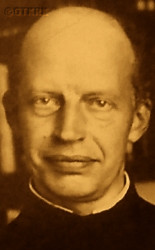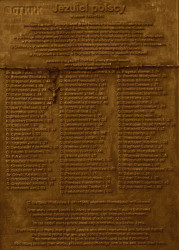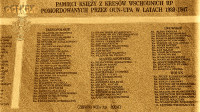Roman Catholic
St Sigismund parish
05-507 Słomczyn
85 Wiślana Str.
Konstancin deanery
Warsaw archdiocese, Poland
full list:
displayClick to display full list

searchClick to search full list by categories
wyświetlKliknij by wyświetlić pełną listę po polsku

szukajKliknij by przeszukać listę wg kategorii po polsku

Martyrology of the clergy — Poland
XX century (1914 – 1989)
personal data
surname
SKIBNIEWSKI
forename(s)
Dominic Marius (pl. Dominik Mariusz)
forename(s)
versions/aliases
Marian
function
religious cleric
creed
Latin (Roman Catholic) Church RCmore on
en.wikipedia.org
[access: 2014.09.21]
congregation
Society of Jesus SImore on
en.wikipedia.org
[access: 2014.09.21]
(i.e. Jesuits)
diocese / province
Lesser Poland Province SI (from 1926)
Polish Province SI (1918‐1926)
Galicia Province SI (till 1918)
academic distinctions
Doctor of Philosophy
Doctor of Theology
date and place
of death
27.09.1939

Prylbychitoday: Novoiavorivsk urban hrom., Yavoriv rai., Lviv obl., Ukraine
more on
en.wikipedia.org
[access: 2023.03.02]
alt. dates and places
of death
28.09.1939
details of death
During World War I for a short time chaplain of the Italian Tyrol Riflemen and at military hospital for POWs in Kraków (1914‐1915), After German and Russian invasion of Poland in 09.1939 and start of the World War II chaplain at a field hospital set up at Leo Szeptycki's (Greek Catholic archbishop of Lviv archeparchy Andrew Szeptycki's brother) manor.
There murdered, together with Leo Szeptycki and his family — according to some sources by Russians, who just started to occupy part of Poland, according to others by the Ukrainian nationalists, members of genocidal Ukrainian OUN organization.
Murderers forced the victims to dig their own graves.
cause of death
mass murder
perpetrators
Russians / Ukrainians
sites and events
«Genocidium Atrox»Click to display the description, Ribbentrop‐MolotovClick to display the description, Pius XI's encyclicalsClick to display the description
date and place
of birth
20.04.1881

Balychitoday: Shehyni hrom., Yavoriv rai., Lviv obl., Ukraine
more on
en.wikipedia.org
[access: 2022.08.05]
alt. dates and places
of birth
Babicetoday: Krzywcza gm., Przemyśl pov., Subcarpathia voiv., Poland
more on
en.wikipedia.org
[access: 2021.12.18]
parents
SKIBNIEWSKI Bronislav Alexander Anthony
🞲 23.05.1830, Vovkivtsitoday: Rozsosha hrom., Proskuriv/Khmelnytskyi rai., Proskuriv/Khmelnytskyi obl., Ukraine
more on
uk.wikipedia.org
[access: 2025.02.20] — 🕆 27.06.1904, Balychitoday: Shehyni hrom., Yavoriv rai., Lviv obl., Ukraine
more on
en.wikipedia.org
[access: 2022.08.05]

DZIEDUSZYCKA Olga
🞲 08.06.1844, Sydorivkatoday: Zhuravne hrom., Stryi rai., Lviv obl., Ukraine
more on
uk.wikipedia.org
[access: 2025.02.20] — 🕆 13.05.1931, Balychitoday: Shehyni hrom., Yavoriv rai., Lviv obl., Ukraine
more on
en.wikipedia.org
[access: 2022.08.05]
religious vows
25.03.1920 (permanent)
presbyter (holy orders)
ordination
28.10.1906

Rometoday: Rome prov., Lazio reg., Italy
more on
en.wikipedia.org
[access: 2021.12.18]
positions held
1938 – 1939
lecturer — Stara Wieśtoday: Brzozów gm., Brzozów pov., Subcarpathia voiv., Poland
more on
en.wikipedia.org
[access: 2021.12.18] ⋄ Assumption of the Blessed Virgin Mary monastery, Jesuits SI — professor of German language at the novitiate
1937 – 1938
spiritual father — Dziedzicetoday: neighborhood in Czechowice‐Dziedzice, Czechowice‐Dziedzice gm., Bielsko‐Biała pov., Silesia voiv., Poland
more on
pl.wikipedia.org
[access: 2021.12.19] ⋄ Department of Theology, St Joseph monastery (Retreat House), Jesuits SI
1935 – 1937
lecturer — Rometoday: Rome prov., Lazio reg., Italy
more on
en.wikipedia.org
[access: 2021.12.18] ⋄ Pontifical Oriental Institute (Lat. Pontificium Institutum Orientale) — professor of Eastern Churches history
1929 – 1935
secretary — Lublintoday: Lublin city pov., Lublin voiv., Poland
more on
en.wikipedia.org
[access: 2021.08.20] ⋄ management board, Lublin Branch, Polish Historical Society
1926 – 1935
lecturer — Lublintoday: Lublin city pov., Lublin voiv., Poland
more on
en.wikipedia.org
[access: 2021.08.20] ⋄ Theological Department („Bobolanum” college), St Peter the Apostle monastery, Jesuits SI — professor of Church history (1926‐1935), history of missions and liturgy (1932‐1935)
1921 – 1926
lecturer — Krakówtoday: Kraków city pov., Lesser Poland voiv., Poland
more on
en.wikipedia.org
[access: 2021.06.07] ⋄ college (Lat. Collegium Maximum SS. Cordis Iesu), 26 Kopernik Str., monastery (by the Holiest Heart of Jesus church), Jesuits SI — professor of Church history
1918 – 1921
lecturer — Stara Wieśtoday: Brzozów gm., Brzozów pov., Subcarpathia voiv., Poland
more on
en.wikipedia.org
[access: 2021.12.18] ⋄ College, Assumption of the Blessed Virgin Mary monastery, Jesuits SI — professor of general and Polish history (1920‐1921), Church history (1918‐1920)
1917 – 1918
lecturer — Dziedzicetoday: neighborhood in Czechowice‐Dziedzice, Czechowice‐Dziedzice gm., Bielsko‐Biała pov., Silesia voiv., Poland
more on
pl.wikipedia.org
[access: 2021.12.19] ⋄ Department of Theology, St Joseph monastery (Retreat House), Jesuits SI — professor of history
1916 – 1917
Third Probation — Kalksburgtoday: Liesing district in Vienna, Vienna state, Austria
more on
en.wikipedia.org
[access: 2022.11.09] ⋄ College, Jesuits SI — teacher of French literature
1915
lecturer — Dziedzicetoday: neighborhood in Czechowice‐Dziedzice, Czechowice‐Dziedzice gm., Bielsko‐Biała pov., Silesia voiv., Poland
more on
pl.wikipedia.org
[access: 2021.12.19] ⋄ Department of Theology, St Joseph monastery (Retreat House), Jesuits SI — professor of history
1911 – 1915
student — Krakówtoday: Kraków city pov., Lesser Poland voiv., Poland
more on
en.wikipedia.org
[access: 2021.06.07] ⋄ history and geography, Jagiellonian University UJ — prob. state examination for a secondary school teacher in 1916
1910 – 1911
student — Krakówtoday: Kraków city pov., Lesser Poland voiv., Poland
more on
en.wikipedia.org
[access: 2021.06.07] ⋄ theology, College (Lat. Collegium Maximum SS. Cordis Iesu, 26 Kopernik Str.), Jesuits SI — Jesuit supplementary studies
1909 – 1910
teacher — Bunkovychin .Khyriv
today: Khyriv urban hrom., Sambir rai., Lviv obl., Ukraine
more on
uk.wikipedia.org
[access: 2022.11.09] ⋄ St Joseph College („Khyriv” Scientific and Educational Institute), Jesuits SI — professor of French language
1908 – 1909
student — Krakówtoday: Kraków city pov., Lesser Poland voiv., Poland
more on
en.wikipedia.org
[access: 2021.06.07] ⋄ theology, College (Lat. Collegium Maximum SS. Cordis Iesu, 26 Kopernik Str.), Jesuits SI — Jesuit supplementary studies
1907 – 1908
novitiate — Stara Wieśtoday: Brzozów gm., Brzozów pov., Subcarpathia voiv., Poland
more on
en.wikipedia.org
[access: 2021.12.18] ⋄ Assumption of the Blessed Virgin Mary monastery, Jesuits SI
24.10.1907
accession — Stara Wieśtoday: Brzozów gm., Brzozów pov., Subcarpathia voiv., Poland
more on
en.wikipedia.org
[access: 2021.12.18] ⋄ Assumption of the Blessed Virgin Mary monastery, Jesuits SI
till 1907
PhD student — Rometoday: Rome prov., Lazio reg., Italy
more on
en.wikipedia.org
[access: 2021.12.18] ⋄ philosophy and theology, „Gregorianum” [i.e. Lat. Pontificia Universitas Gregoriana (Eng. Pontifical Gregorian University)] — resident at Pontifical Roman German and Hungarian College (Lat. Pontificium Collegium Germanicum et Hungaricum de Urbe), known as „Collegium Germanicum”; public defense PhD thesis in philosophy in 1903 and in theology in 1907
from 1900
student — Rometoday: Rome prov., Lazio reg., Italy
more on
en.wikipedia.org
[access: 2021.12.18] ⋄ philosophy and theology, „Gregorianum” [i.e. Lat. Pontificia Universitas Gregoriana (Eng. Pontifical Gregorian University)] — resident: Pontifical Roman German and Hungarian College (Lat. Pontificium Collegium Germanicum et Hungaricum de Urbe), known as „Collegium Germanicum”
1898 – 1900
pupil — Bunkovychin .Khyriv
today: Khyriv urban hrom., Sambir rai., Lviv obl., Ukraine
more on
uk.wikipedia.org
[access: 2022.11.09] ⋄ St Joseph College („Khyriv” Scientific and Educational Institute), Jesuits SI
associate of „General Review”, „Pedagogical Quarterly”, „Priestly Atheneum”, author of many historical works, i.a. „Impressions from the Roman Campaign: Campaign as a Geographical and Historical Unit”, Kraków, 1918; „Didactic Importance of History in Secondary Schools”, Lublin 1933
sites and events
descriptions
«Genocidium Atrox»: In 1939‐1947, especially in 1943‐1944, independent Ukrainian units, mainly belonging to genocidal Ukrainian organizations OUN (political arm) and UPA (military arm), supported by local Ukrainian population, murdered — often in extremely brutal way — in Volyn and surrounding regions of pre‐war Poland, from 130,000 to 180,000 Poles, all civilians: men, women, children, old and young. Polish‐Ukrainian conflict that openly emerged during and after World War I (in particular resulting in Polish‐Ukrainian war of 1918‐1919), that survived and even deepened later when western Ukraine became a part Poland, exploded again after the outbreak of the World War II in 09.1939. During Russian occupation of 1939‐1941, when hundreds of thousands of Poles were deported into central Russia, when tens of thousands were murdered (during so‐called Katyń massacres, among others), this open conflict had a limited character, helped by the fact that at that time Ukrainians, Ukrainian nationalists in particular, were also persecuted by the Russians. The worst came after German‐Russian war started on 22.06.1941 and German occupation resulted. Initially Ukrainians supported Germans (Ukrainian police was initiated, Ukrainians co—participated in extermination of the Jews and were joining army units fighting alongside Germans). Later when German ambivalent position towards Ukraine became apparent Ukrainians started acting independently. And in 1943 one of the units of aforementioned Ukrainian OUN/UPA organization, in Volyn, started and perpetrated a genocide of Polish population of this region. In mere few weeks OUN/UPA murdered, with Germans passively watching on the sidelines, more than 40,000 Poles. This strategy was consequently approved and adopted by all OUN/UPA organisations and similar genocides took place in Eastern Lesser Poland (part of Ukraine) where more than 20,000 Poles were slaughtered, meeting however with growing resistance from Polish population. Further west, in Chełm, Rzeszów, etc. regions this genocide turned into an extremely bloody conflict. In general genocide, perpetrated by Ukrainian nationalists, partly collaborating with German occupants, on vulnerable Polish population took part in hundreds of villages and small towns, where virtually all Polish inhabitants were wiped out. More than 200 priests, religious and nuns perished in this holocaust — known as «Genocidium Atrox» (Eng. „savage genocide”) The nature and purpose of genocide is perhaps best reflected in the song sung by the murderers: „We will slaughter the Poles, we will cut down the Jews, we must conquer the great Ukraine” (ukr. „Поляків виріжем, Євреїв видусим, велику Україну здобути мусим”). This holocaust and conflict ended up in total elimination of Polish population and Polish culture from Ukraine, in enforced deportations in 1944‐1945 of remaining Poles from Ukraine and some Ukrainians into Ukraine proper, and finally in deportation of Ukrainians from East‐South to the Western parts of Polish republic prl by Commie‐Nazi Russian controlled Polish security forces („Vistula Action”). (more on: www.swzygmunt.knc.plClick to attempt to display webpage
[access: 2021.06.20])
Ribbentrop‐Molotov: Genocidal Russian‐German alliance pact between Russian leader Joseph Stalin and German leader Adolf Hitler signed on 23.08.1939 in Moscow by respective foreign ministers, Mr. Vyacheslav Molotov for Russia and Joachim von Ribbentrop for Germany. The pact sanctioned and was the direct cause of joint Russian and German invasion of Poland and the outbreak of the World War II in 09.1939. In a political sense, the pact was an attempt to restore the status quo ante before 1914, with one exception, namely the „commercial” exchange of the so‐called „Kingdom of Poland”, which in 1914 was part of the Russian Empire, fore Eastern Galicia (today's western Ukraine), in 1914 belonging to the Austro‐Hungarian Empire. Galicia, including Lviv, was to be taken over by the Russians, the „Kingdom of Poland” — under the name of the General Governorate — Germany. The resultant „war was one of the greatest calamities and dramas of humanity in history, for two atheistic and anti‐Christian ideologies — national and international socialism — rejected God and His fifth Decalogue commandment: Thou shall not kill!” (Abp Stanislav Gądecki, 01.09.2019). The decisions taken — backed up by the betrayal of the formal allies of Poland, France and Germany, which on 12.09.1939, at a joint conference in Abbeville, decided not to provide aid to attacked Poland and not to take military action against Germany (a clear breach of treaty obligations with Poland) — were on 28.09.1939 slightly altered and made more precise when a treaty on „German‐Russian boundaries and friendship” was agreed by the same murderous signatories. One of its findings was establishment of spheres of influence in Central and Eastern Europe and in consequence IV partition of Poland. In one of its secret annexes agreed, that: „the Signatories will not tolerate on its respective territories any Polish propaganda that affects the territory of the other Side. On their respective territories they will suppress all such propaganda and inform each other of the measures taken to accomplish it”. The agreements resulted in a series of meeting between two genocidal organization representing both sides — German Gestapo and Russian NKVD when coordination of efforts to exterminate Polish intelligentsia and Polish leading classes (in Germany called «Intelligenzaktion», in Russia took the form of Katyń massacres) where discussed. Resulted in deaths of hundreds of thousands of Polish intelligentsia, including thousands of priests presented here, and tens of millions of ordinary people,. The results of this Russian‐German pact lasted till 1989 and are still in evidence even today. (more on: en.wikipedia.orgClick to attempt to display webpage
[access: 2015.09.30])
Pius XI's encyclicals: Facing the creation of two totalitarian systems in Europe, which seemed to compete with each other, though there were more similarities than contradictions between them, Pope Pius XI issued in 03.1937 (within 5 days) two encyclicals. In the „Mit brennender Sorge” (Eng. „With Burning Concern”) published on 14.03.1938, condemned the national socialism prevailing in Germany. The Pope wrote: „Whoever, following the old Germanic‐pre‐Christian beliefs, puts various impersonal fate in the place of a personal God, denies the wisdom of God and Providence […], whoever exalts earthly values: race or nation, or state, or state system, representatives of state power or other fundamental values of human society, […] and makes them the highest standard of all values, including religious ones, and idolizes them, this one […] is far from true faith in God and from a worldview corresponding to such faith”. On 19.03.1937, published „Divini Redemptoris” (Eng. „Divine Redeemer”), in which criticized Russian communism, dialectical materialism and the class struggle theory. The Pope wrote: „Communism deprives man of freedom, and therefore the spiritual basis of all life norms. It deprives the human person of all his dignity and any moral support with which he could resist the onslaught of blind passions […] This is the new gospel that Bolshevik and godless communism preaches as a message of salvation and redemption of humanity”… Pius XI demanded that the established human law be subjected to the natural law of God , recommended the implementation of the ideal of a Christian state and society, and called on Catholics to resist. Two years later, National Socialist Germany and Communist Russia came together and started World War II. (more on: www.vatican.vaClick to attempt to display webpage
[access: 2023.05.28], www.vatican.vaClick to attempt to display webpage
[access: 2023.05.28])
sources
personal:
www.kresykedzierzynkozle.home.plClick to attempt to display webpage
[access: 2013.01.13], pl.wikipedia.orgClick to attempt to display webpage
[access: 2013.01.13], www.kchodorowski.republika.plClick to attempt to display webpage
[access: 2013.01.26], archive.todayClick to attempt to display webpage
[access: 2021.12.19]
bibliographical:
„Register of Latin rite Lviv metropolis clergy’s losses in 1939‐45”, Józef Krętosz, Maria Pawłowiczowa, editors, Opole, 2005
„Biographical lexicon of Lviv Roman Catholic Metropoly clergy victims of the II World War 1939‐1945”, Mary Pawłowiczowa (ed.), Fr Joseph Krętosz (ed.), Holy Cross Publishing, Opole, 2007
„Jesuits on Polish and Lithuanian territory knowledge encyclopedia, 1564‐1995”, Fr Louis Grzebień SI (editor), WAM Printing House, Cracow 1996
„Mysterium iniquitatis. Clergy and religious of the Latin rite murdered by Ukrainian nationalists in 1939‐1945”, Fr Józef Marecki, Institute of National Remembrance IPN, Kraków 2020
original images:
www.kchodorowski.republika.plClick to attempt to display webpage
[access: 2013.01.26], www.miejscapamiecinarodowej.plClick to attempt to display webpage
[access: 2014.05.09], wegliniec.plClick to attempt to display webpage
[access: 2014.10.31], ipn.gov.plClick to attempt to display webpage
[access: 2019.02.02]
LETTER to CUSTODIAN/ADMINISTRATOR
If you have an Email client on your communicator/computer — such as Mozilla Thunderbird, Windows Mail or Microsoft Outlook, described at WikipediaPatrz:
en.wikipedia.org, among others — try the link below, please:
LETTER to CUSTODIAN/ADMINISTRATORClick and try to call your own Email client
If however you do not run such a client or the above link is not active please send an email to the Custodian/Administrator using your account — in your customary email/correspondence engine — at the following address:

giving the following as the subject:
MARTYROLOGY: SKIBNIEWSKI Dominic Marius
To return to the biography press below:
 Click to return to biography
Click to return to biography











